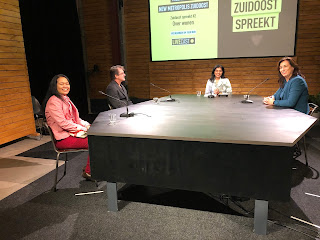Open Monumentendag
The Open Monumentendag (Heritage Days) is designed to bring people into contact with the historic environment, and to encourage interest in and understanding of historical monuments and the need for their preservation. During the Open Monumentendag - every second weekend of September - thousands of historical buildings and sites (about 4,000) are open to the public free of charge. Besides opening their doors, many locations also organise on-site activities like exhibitions, music and guided tours. Each year around 80 to 85 percent of Dutch municipalities participate in the Open Monumentendag, organised by local committees. In recent years around 900,000 visitors have participated annually, making the Open Monumentendag one of the Netherlands' premier cultural events.
The Open Monumentendag in the Netherlands started in 1987 and is co-ordinated nationally by the Stichting Open Monumentendag, which has its office in Amsterdam. The Open Monumentendag is part of an international organisation, the European Heritage Days. The Netherlands was one of the first countries to participate and played a key-role in establishing this Europe-wide phenomenon in the 1990s. Today 48 countries are affiliated with the European Heritage Days, which attracts around 20 million visitors every September and October, all keen to explore Europe’s cultural heritage.
Open Monumentendag has established itself as an integral part of the Dutch cultural calendar and has helped significantly in rallying support for the preservation of historical monuments in the Netherlands.
Theme 2008: Traces
Traces: Archaeology and History of Building
In 2008, the European Heritage Day in the Netherlands in the weekend of 13 and 14 September is about Traces. All kinds of traces: in the landscape, in cities and villages, and in historical monuments. As a theme, Traces provides ample space for archaeology and history of building. These are subjects that receive considerable attention in the Netherlands. Archaeology in particular thanks to the 2007 law regarding preservation and care of archaeological sites, which specifically defines and regulates protection for all subterranean historical monuments. While research into the structural history of buildings plays an increasingly important role in the conservation of historical monuments.Wide Assortment
Nearly all the country’s 350 participating local committees have adopted the theme, resulting in a wide range of open monuments and activities. Among the features this year are landscape elements such as barrows, burial mounds, raised villages, and walled castles; in the cities and villages the focus is on church aisles, street plans, advertising on walls and plaques. Traces inside historical monuments also plays its part, traces such as ancient beams, floors and other architectural elements, as well as old wallpaper, murals and upholstery. Traces includes any remains or reference to what used to be. Traces may point to occupation, construction or the struggle to control the water and protect the land. (resource : http://www.openmonumentendag.nl/)
The Open Monumentendag in the Netherlands started in 1987 and is co-ordinated nationally by the Stichting Open Monumentendag, which has its office in Amsterdam. The Open Monumentendag is part of an international organisation, the European Heritage Days. The Netherlands was one of the first countries to participate and played a key-role in establishing this Europe-wide phenomenon in the 1990s. Today 48 countries are affiliated with the European Heritage Days, which attracts around 20 million visitors every September and October, all keen to explore Europe’s cultural heritage.
Open Monumentendag has established itself as an integral part of the Dutch cultural calendar and has helped significantly in rallying support for the preservation of historical monuments in the Netherlands.
Theme 2008: Traces
Traces: Archaeology and History of Building
In 2008, the European Heritage Day in the Netherlands in the weekend of 13 and 14 September is about Traces. All kinds of traces: in the landscape, in cities and villages, and in historical monuments. As a theme, Traces provides ample space for archaeology and history of building. These are subjects that receive considerable attention in the Netherlands. Archaeology in particular thanks to the 2007 law regarding preservation and care of archaeological sites, which specifically defines and regulates protection for all subterranean historical monuments. While research into the structural history of buildings plays an increasingly important role in the conservation of historical monuments.Wide Assortment
Nearly all the country’s 350 participating local committees have adopted the theme, resulting in a wide range of open monuments and activities. Among the features this year are landscape elements such as barrows, burial mounds, raised villages, and walled castles; in the cities and villages the focus is on church aisles, street plans, advertising on walls and plaques. Traces inside historical monuments also plays its part, traces such as ancient beams, floors and other architectural elements, as well as old wallpaper, murals and upholstery. Traces includes any remains or reference to what used to be. Traces may point to occupation, construction or the struggle to control the water and protect the land. (resource : http://www.openmonumentendag.nl/)



Comments